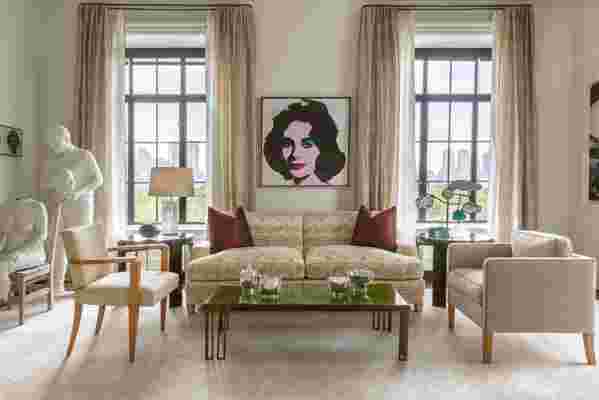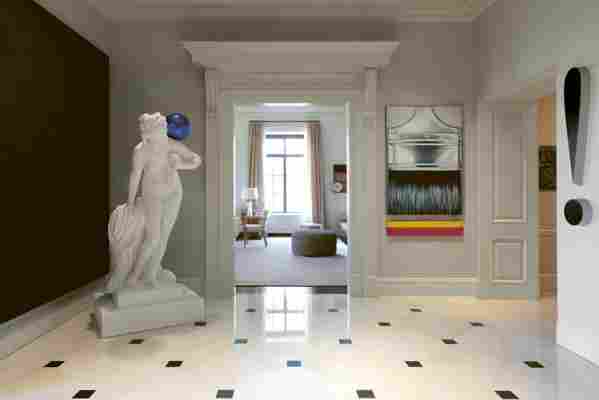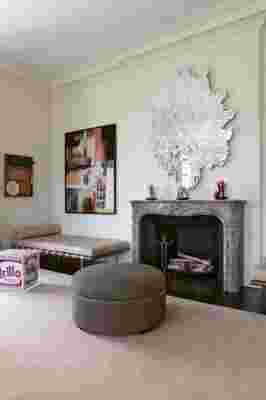A Stunning Art Collection—and Careful Use of Natural Light—Set the Tone in This NYC Designer’s Home
“I learned to be good at making concessions,” says Barbara Lane of her experience as an interior designer for over 40 years. “You just have to check your ego at the door.” With more than 50 global design projects to her name, many of which are documented in her recently published book Barbara Lane Interiors (which is published by Pointed Leaf Press and hits the shelves this spring), Lane has been making her mark in homes across the globe for decades. And perhaps the most notable mark has been made in her own home, on Fifth Avenue in Manhattan, in an apartment that overlooks Central Park and is packed with the kind of art that should (and sometimes does) hang on the walls of museums around the world. And that’s what makes Lane distinctive: Unlike most interior decorators, her passion and experience as a collector of groundbreaking international artists marries art and objects in a truly personal way.
What drew Lane to her primary home of 30-plus years was not the classic moldings or the nearly floor-to-ceiling windows that look down onto miles of green. Instead, it was, unsurprisingly, its walls: “We came from an apartment with too many windows. We moved to have walls. We needed them,” she says. On top of designing interiors for nearly half a century, Lane and her husband have spent much of their life collecting art. Big art. Names that are renowned worldwide, from Cy Twombly to Cindy Sherman to Jeff Koons . “We started off collecting prints and multiples by artists we liked from the ’60s,” Lane says. “When we could afford it, we began to buy their later work, which we’ve now sold off in exchange for earlier work.” This was a shrewd move based on years of auction-hopping and traveling the world acquiring objects, both for herself and her clients, along the way.
To showcase their many photographs, paintings, and drawings, the couple needed less light and more surface area. In the back of the house is a hallway paved with drawings by some of the pop artists they love—Rauschenberg, Warhol, Johns, to name a few—which exists sort of like their very own gallery. It’s in-between space tucked alongside the kitchen, where Lane says she spends a lot of time, whether it’s “just passing through, or perusing the works with guests.”

The living room is one of the brightest rooms in the house, with views overlooking Central Park. Key pieces include the sofa, the Jean Royère coffee table, and Warhol’s Liz . To the left is an upholstered chair by Jacques Quinet , which faces an armchair by Francis Jourdain . The sofa was designed by Lane herself and is covered in Le Manach fabric.
Their sculptures, of which they have several, can spend time in the light—and that is where they come alive. Take their George Segal, which poses on the far left side of the living room in contrapposto, is a two-part plaster sculpture. This duo can be found sunning next to Warhol’s Liz , which hangs, desultory, in the room’s center, just left of their landscape mobile by Lichtenstein . As if the room weren’t packed with enough multimedia prestige and craftsmanship, the furniture too has stories of its own. There’s the sofa, which Lane designed herself and covered with Le Manach fabric, the green-enamel Royère coffee table, and a rug whose designer Lane can’t seem to place, not that she can be blamed for that. “Maybe Edward Fields, I can’t be sure,” she says.
Lane seems to waffle between choosing what comes first—art or design: “That would be like picking my favorite piece—it’s Sophie’s Choice .” To balance both elements, the designer chose to paint the apartment in a mostly neutral palette. Colorist Donald Kaufman custom designed a flight of white paints throughout the home, a mutual decision made so that the art could pop. The only room that isn’t painted modestly is the couple’s wood-paneled library, which has the most colorful art in the house. “This room changed with us. And it changed the most,” Lane says. To keep a 30-year-old home feeling new, Lane is devoted to the art of tweaking: “It’s not about making big changes, it’s a matter of switching something out for something else,” she says. “Sometimes things go out to a museum and we replace it with something else. It’s important to look at your art in a different way.”
The couple recently renovated their library in order to modernize it and make room for more art. What used to be in dark mahogany is now updated in light oak; they took out the bookshelves and played around more with contrasting textiles and textures. And, of course, there’s art: Lichtenstein’s Still Life With Cabbage sandwiched between Ed Ruscha’s Honk and Warhol’s Portrait of Judith Green —“one of Warhol’s groupies,” Lane makes sure to note. On the opposite side of the room you have more Warhol, a Claes Oldenberg “inspired by an Arm and Hammer box,” says Lane, and a Robert Indiana titled The Rebecca , named after a ship bound for New York carrying enslaved people. In the midst of all this work, Lane mixed and matched an abstract rug by Parsua , a sofa in a luxurious silk velvet, and leopard ottomans in a silk velvet.


Buy now for unlimited access and all of the benefits that only members get to experience.
Lane’s favorite room, most surprisingly, is the most quiet: the bedroom. That is where she spends most of her time. “I’m a bedroom person. I love the light. I love my books. I like to write in bed.” She laughs because that’s where she is right now. Unlike her paintings, Lane says she “[needs] a bedroom to have light and air.” But don’t let the quiet subtlety of the room fool you: Above the bed hangs an expansive Sol Lewitt. Lane admits, pridefully, that in order to fit the geometric comb-like sculpture there, they had to cut a piece of the moulding to fit. “That’s how you know we’re serious,” she says. The love seat at the end, which at first glance looks arboreal—perhaps made of twigs and strips of wood—is actually a bronze piece by Claude Lalanne . One of six, Lane says.
The specificity with which Lane talks about each piece—its name, its origin, and acquisition story—feels spirited, and almost brings each work to life. These are not just objects in a collection, they are memories and milestones. Points of pride, company for her company. And yet, Lane misses the opportunity to share her space with others. She has been away from New York, staying in Miami, and hasn’t been back to her apartment since November. She’s starting to feel homesick, she says: “I’m not a Florida person. I miss my apartment. I miss New York. I miss New York life. Everyone does. Because you know why? There’s just nothing else like it.”